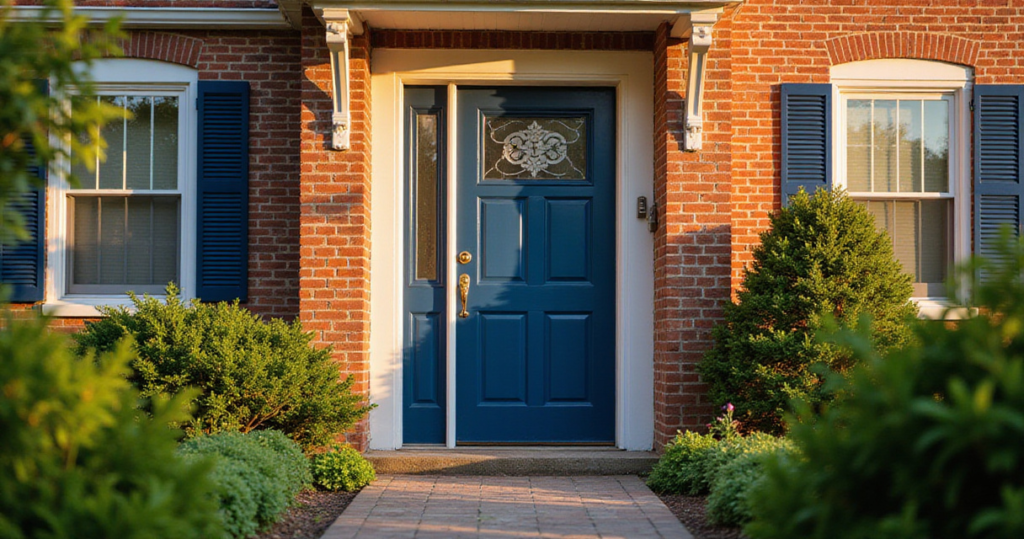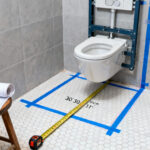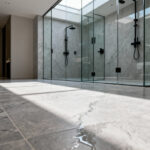Your front door sets the stage for every visitor’s experience, creating that crucial first impression that can make or break how people perceive your home. As a pet-friendly design specialist, I’ve seen countless entryways that miss the mark—not just aesthetically, but practically too. The best front door decorations work for everyone in your household, including your four-legged family members, while creating an inviting atmosphere that reflects your unique style.
The impact of a well-decorated entrance extends far beyond curb appeal. Studies consistently show that homes with thoughtfully designed front doors can increase property value by up to 7%, while also reducing time on market. But here’s what most homeowners don’t consider: your decorations need to withstand daily life with pets, weather extremes, and constant use while maintaining their beauty.
From durable materials that can handle muddy paws to lighting solutions that keep everyone safe during evening walks, these 24 front door decoration ideas blend style with real-world functionality. Whether you’re working with a grand colonial entrance or a cozy apartment door, you’ll discover practical solutions that create lasting beauty without compromising on the needs of your entire family—pets included.
1. Choose Pet-Safe Paint Colors for Maximum Impact
Selecting the right front door color transforms your entrance instantly, but when you share your home with pets, this choice requires extra consideration. The most stunning door colors work harmoniously with your home’s architecture while using pet-safe, non-toxic formulations that won’t harm curious cats or dogs who might investigate with their noses and tongues.
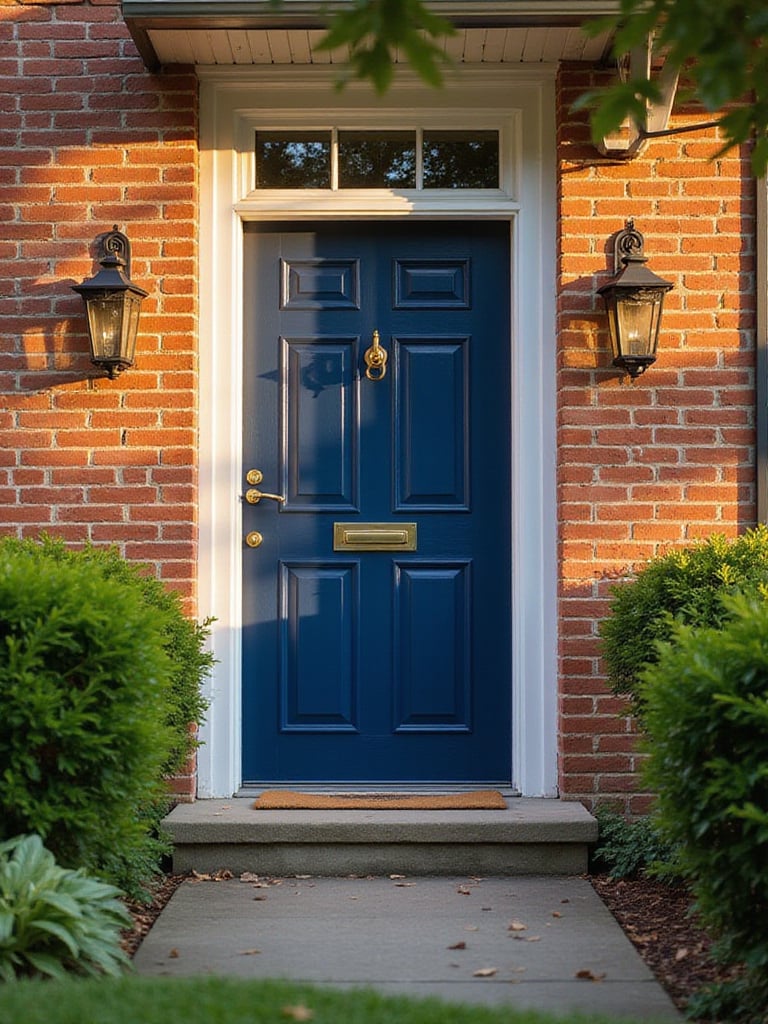
From my veterinary background, I always recommend zero-VOC or low-VOC paints specifically labeled as pet-safe. Colors like deep navy, forest green, or classic black not only photograph beautifully but also hide inevitable nose prints and light scratches from excited pets greeting visitors. A client recently painted their door a gorgeous “Hale Navy” using Benjamin Moore’s Natura line—completely pet-safe and still vibrant after two years of their golden retriever’s enthusiastic door greetings.
The magic happens when you consider your pets’ behavior patterns alongside color psychology. Warm colors like terracotta or sage green create welcoming energy while being forgiving of daily wear from pet traffic.
2. Install Durable Hardware That Withstands Pet Activity
Upgrading your door hardware requires special consideration when pets are involved—you need pieces that can handle everything from jumping dogs to cats using door handles as climbing aids. Quality hardware made from solid brass or stainless steel resists scratches and maintains its finish despite constant pet interaction.

I recommend handlesets with smooth, rounded edges that won’t catch pet collars or leashes, and finishes like oil-rubbed bronze or matte black that naturally camouflage light scratches. A recent client installed a Schlage handleset with a keypad entry—perfect for dog walkers and pet sitters who need access without fumbling for keys while managing excited pets. The antimicrobial coating also helps reduce bacteria transfer from pet paws to human hands.
Key features for pet-friendly hardware:
- Smooth, rounded edges that won’t snag collars
- Antimicrobial finishes for hygiene
- Keypad or smart lock options for pet care providers
- Heavy-duty construction to handle jumping and scratching
Look closely and you’ll notice the subtle difference quality hardware makes in creating a polished entrance that works beautifully for both human and pet family members.
3. Design Strategic Lighting for Pet Safety and Security
Effective front door lighting serves dual purposes in pet households—creating beautiful ambiance while ensuring safety for evening walks and late-night potty breaks. Motion-sensor lights provide hands-free illumination when you’re juggling leashes, keys, and potentially muddy paws, while also deterring unwanted visitors when you’re away.
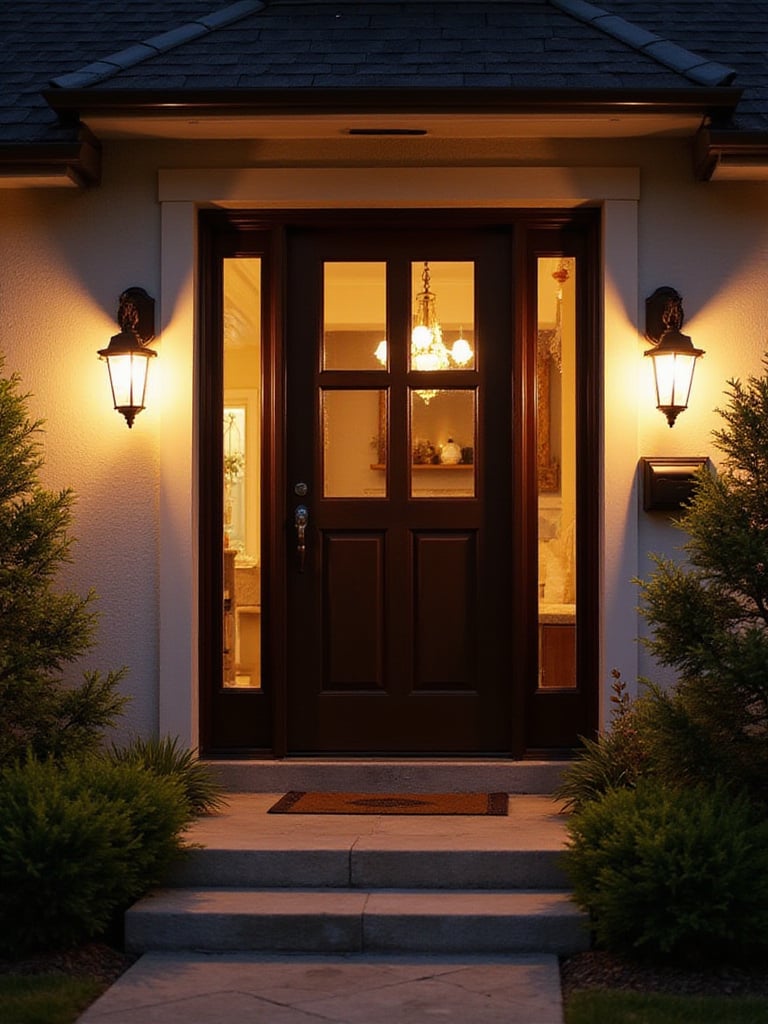
LED fixtures offer the best combination of energy efficiency and pet safety, producing minimal heat that won’t burn curious noses. I particularly love solar-powered path lights that create a gentle runway effect leading to your door—perfect for senior dogs with vision issues or puppies still learning their way around. One client installed smart bulbs that gradually dim in the evening, helping their anxious rescue dog feel more secure during the transition from day to night.
The interplay between ambient lighting and accent features creates depth while addressing practical concerns like illuminating potential hazards like steps or planters that pets might navigate in low light.
4. Select Antimicrobial Doormats for Easy Maintenance
A high-quality doormat becomes your first line of defense against tracked-in dirt, but in pet households, it needs to handle mud, water, and occasional accidents while remaining hygienic and attractive. Antimicrobial materials like natural coir or synthetic options with built-in bacteria resistance keep your entrance fresh and welcoming.

Size matters significantly with pets—opt for oversized mats (at least 3×5 feet) that can accommodate large dogs shaking off after walks or multiple pets congregating at the door. Rubber-backed options stay put even when enthusiastic dogs bound across them, while raised textures provide excellent paw cleaning. I recommend having two identical mats so you can rotate them for washing—essential when dealing with muddy paw prints or seasonal shedding.
Benefits of antimicrobial doormats:
- Naturally resist odor-causing bacteria
- Easy to hose down and sanitize
- Durable enough for heavy pet traffic
- Available in stylish patterns that hide dirt
What makes this choice better for our planet is that many antimicrobial mats use naturally occurring materials like coconut fiber, which biodegrades at the end of its useful life.
5. Create Pet-Friendly Planter Arrangements
Symmetrical planters frame your entrance beautifully, but plant selection becomes critical when pets are part of the family. Many traditional landscaping choices like azaleas, lilies, or sago palms are highly toxic to dogs and cats, making careful plant curation essential for a safe, stylish entrance.

Focus on pet-safe options that still provide visual impact: spider plants, Boston ferns, snapdragons, and marigolds offer color and texture without toxicity concerns. Raised planters work better than ground-level options, keeping plants at nose height for humans while discouraging digging from curious dogs. A recent project featured large ceramic planters filled with pet-safe herbs like rosemary and thyme—beautiful, fragrant, and completely safe if pets nibble.
Consider the practical aspects too: choose planters with drainage holes and saucers to prevent water accumulation that attracts mosquitoes, and select materials that won’t tip over when bumped by large dogs. Weighted bases or built-in stability features help maintain your carefully planned symmetry.
The unexpected environmental benefit comes from choosing native, pet-safe plants that support local wildlife while keeping your furry family members healthy.
6. Design All-Season Wreaths with Non-Toxic Materials
An all-season wreath provides year-round beauty, but traditional materials like certain berries, pinecones treated with chemicals, or artificial elements can pose risks to pets who investigate with their mouths. Creating stunning wreaths using verified pet-safe materials ensures your decoration remains beautiful and worry-free.

Base your wreath on safe greenery like eucalyptus, rosemary, or untreated grapevine, then add seasonal accents using pet-safe options: silk flowers instead of potentially toxic real blooms, natural cotton ribbons rather than synthetic materials that could cause intestinal blockages if ingested, and wooden or ceramic ornaments instead of small items that present choking hazards.
Safe wreath materials for pet households:
- Eucalyptus or rosemary base
- Natural cotton or jute ribbons
- Wooden or ceramic decorative elements
- Untreated natural materials
The craftsmanship reveals itself in details like secure attachment methods that prevent small pieces from falling where pets might find them, and weather-resistant construction that maintains safety standards through all seasons.
The sustainable journey of this material choice involves selecting organic, untreated elements that decompose safely if pets do manage to ingest small pieces.
7. Install Illuminated House Numbers for Visibility
Clear, well-lit house numbers serve essential safety functions in pet households—emergency veterinarians, pet sitters, and dog walkers need to locate your home quickly, especially during nighttime emergencies. Illuminated numbers eliminate guesswork and reduce stress during urgent situations.

Solar-powered LED numbers offer the perfect solution: no wiring required, automatic operation, and bright visibility without creating hot surfaces that might burn curious pet noses. Choose numbers at least 6 inches tall with high contrast against your home’s exterior—white numbers on dark siding or black numbers on light surfaces work best. The investment pays off immediately when your regular dog walker can find your home confidently in winter darkness.
Beyond emergency situations, clear numbering helps delivery drivers locate your home efficiently, reducing the likelihood of packages being left at wrong addresses—particularly important for pet medication deliveries or special dietary foods that need timely arrival.
The visual weight balances perfectly when you coordinate number style with your door hardware and lighting fixtures, creating a cohesive look that prioritizes both beauty and function.
8. Choose Pet-Safe Door Knockers and Accessories
A distinctive door knocker adds character while serving practical purposes in pet households, but traditional designs often include small parts or toxic finishes that could harm curious pets. Select knockers made from solid, non-toxic materials with smooth surfaces that won’t catch pet collars or create injury risks.
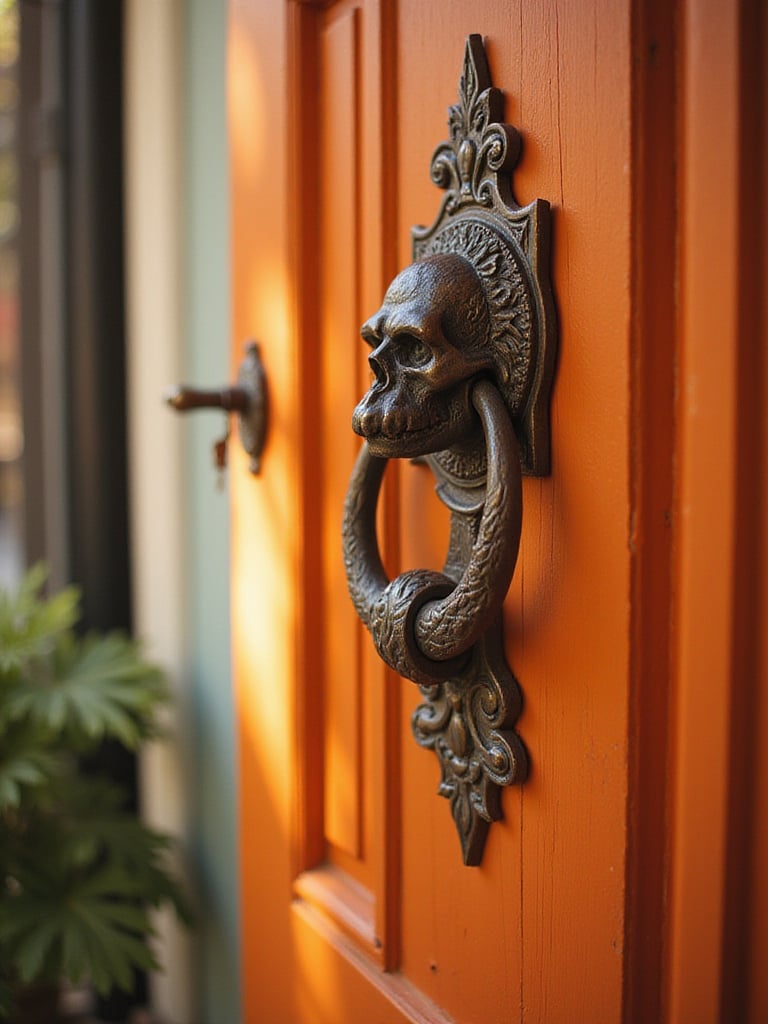
Brass and stainless steel options provide durability and safety, while avoiding painted finishes that might contain lead or other harmful substances. Size matters too—choose substantial knockers that won’t be easily damaged by jumping dogs or swatted by cats, and ensure mounting hardware is completely secure to prevent pieces from becoming choking hazards.
Consider the acoustic impact as well: some pets become anxious with loud door sounds, while others benefit from the auditory cue that visitors are arriving. Test different tones and volumes to find options that work well with your pets’ temperaments and training routines.
The designer’s attention to detail shows in selecting finishes that complement your existing hardware while prioritizing safety—oil-rubbed bronze and brushed nickel naturally resist showing wear from pet interactions.
9. Install Weather-Resistant Garland Systems
Framing your entrance with lush garlands creates dramatic impact, but installation methods must account for pets who might jump, pull, or investigate hanging decorations. Secure mounting systems prevent garlands from becoming hazards while maintaining their decorative appeal through all weather conditions.

Professional-grade hanging systems with reinforced attachment points handle the stress of wind, weather, and occasional pet interference. Choose garlands made from pet-safe materials—artificial options often work better than real greenery that might shed toxic leaves or attract insects. Pre-lit garlands with LED bulbs eliminate the fire risk of traditional lighting while providing enchanting evening illumination.
The key to successful garland installation lies in strategic placement: high enough to avoid curious mouths but low enough to frame your entrance effectively. Use multiple attachment points to distribute weight and prevent sagging that could bring decorations within pet reach.
Installation considerations for pet households:
- Secure mounting at multiple points
- Pet-safe artificial materials
- LED lighting for safety
- Height placement above pet reach
As morning light filters through, the texture creates beautiful shadows while remaining safely out of reach of even the most athletic cats or determined jumping dogs.
10. Create Seasonal Swags with Safe Materials
Door swags offer dynamic visual interest while allowing for creative seasonal updates, but material selection becomes crucial when pets share your space. Unlike traditional arrangements that might include toxic plants or small decorative elements, pet-safe swags focus on larger, secure components that won’t create hazards.
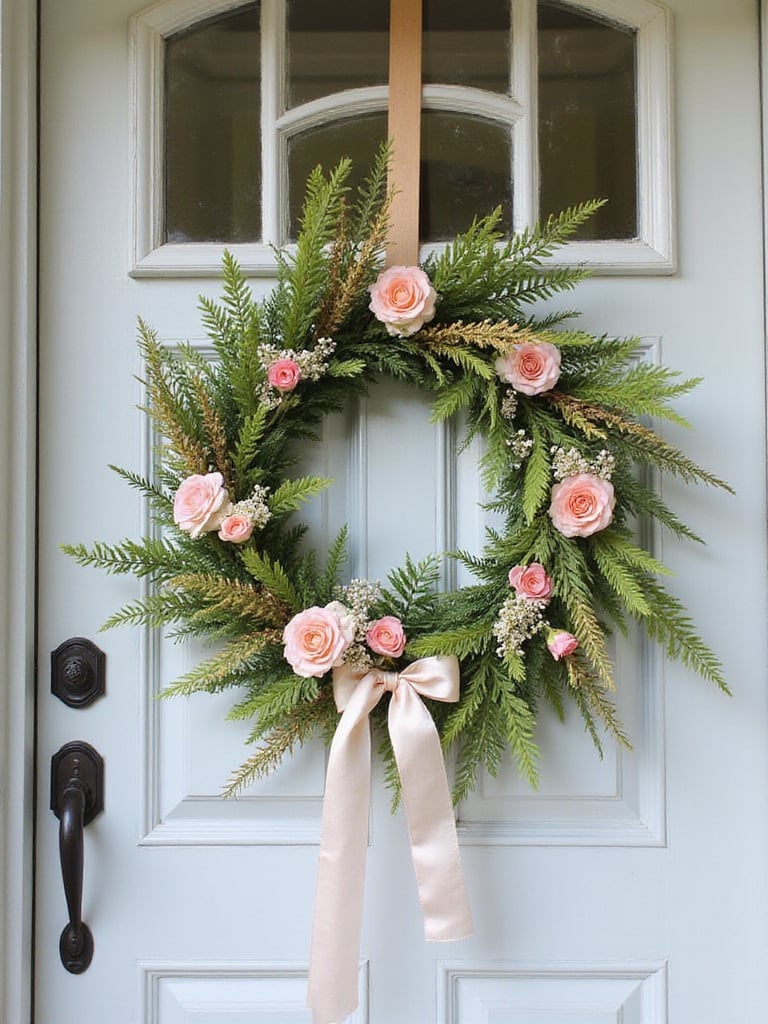
Build swags using substantial base materials like bamboo, untreated wood branches, or thick rope that can’t be easily destroyed or ingested. Layer in pet-safe elements like cotton fabric strips, large wooden beads, or ceramic ornaments that are too big to present choking risks. Avoid small berries, nuts, or artificial elements that could be tempting to curious pets.
The composition comes together when you balance visual appeal with practical safety considerations. Secure all elements firmly to prevent pieces from falling, and position swags high enough to avoid interference from jumping or climbing pets while still creating the desired decorative impact.
The environmental story behind this piece began with selecting renewable, biodegradable materials that pose minimal risk if pets do manage to access small pieces, supporting both home safety and ecological responsibility.
11. Design Custom Welcome Signs with Pet Themes
Personalized welcome signs offer wonderful opportunities to celebrate your pet-loving household while creating inviting curb appeal. Custom designs can incorporate pet silhouettes, paw prints, or family names that include beloved furry members, creating immediate connection with fellow pet lovers while maintaining broad appeal.

Choose durable, weather-resistant materials like marine-grade wood or powder-coated metal that can withstand both weather extremes and occasional pet interaction. Mounting height becomes important—high enough to prevent damage from jumping dogs but positioned where the message remains clearly visible. Consider adding subtle pet-themed elements like paw print borders or bone-shaped accents that add whimsy without overwhelming the design.
The artisans’ commitment to environmental practices means selecting sustainably sourced wood or recycled metal materials, while pet-safe finishes ensure no harmful chemicals leach into the environment where pets spend time.
Elements for pet-themed welcome signs:
- Family name including pet names
- Subtle paw print or silhouette accents
- Weather-resistant, non-toxic materials
- Secure mounting above pet interference level
Professional stylists approach this by first considering the overall aesthetic of your home, then layering in pet-themed elements that feel integrated rather than overwhelming.
12. Layer Pet-Safe Textures for Visual Depth
Creating textural depth at your entrance requires careful material selection when pets are involved—you need surfaces that invite touch while remaining safe for curious noses and paws. Combine natural materials like untreated wood, stone, and cotton textiles that provide sensory interest without toxicity concerns.
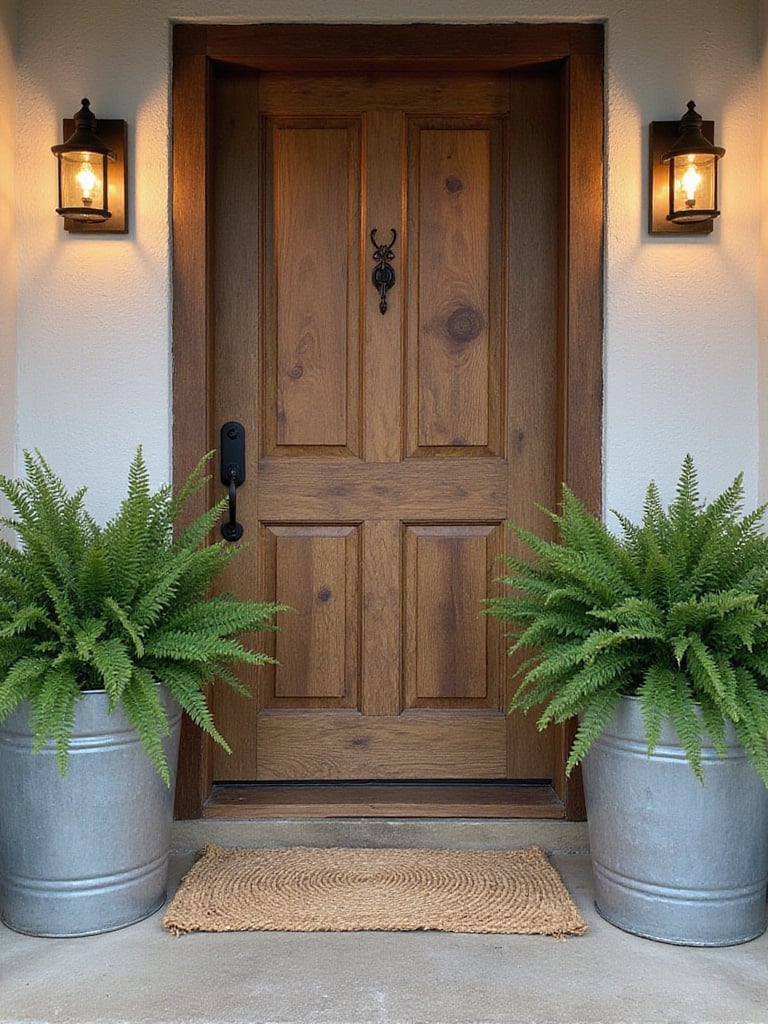
The magic happens in the layering: a substantial coir doormat provides rough texture for paw cleaning, while smooth ceramic planters offer visual contrast and easy cleaning. Add soft elements through cotton or hemp rope accents, natural fiber cushions for seating areas, or woven baskets for storage that doubles as decoration. Each texture serves both aesthetic and practical purposes in pet-friendly design.
Avoid materials that could splinter, chip, or shed harmful particles—skip treated lumber, painted surfaces that might contain lead, or synthetic materials that could cause intestinal blockages if ingested. Natural materials age beautifully and often become more attractive with the gentle wear that comes from pet interaction.
The tactile experience changes the entire entrance’s energy when every surface has been selected for both beauty and safety, creating a welcoming environment that works for all family members.
13. Maximize Vertical Space with Secure Hanging Elements
Utilizing vertical space becomes especially important in pet households where ground-level decorations might face interference from curious or energetic animals. Strategic placement of hanging elements creates visual interest while keeping decorative items safely out of reach of jumping dogs or climbing cats.

Focus on substantial hanging pieces that won’t sway excessively in wind or when buildings vibrate from pet activity inside. Solar-powered hanging lanterns provide beautiful evening ambiance without electrical cords that could present chewing hazards, while hanging planters filled with pet-safe plants add living beauty at appropriate heights.
The installation requires heavy-duty hardware rated for outdoor use and dynamic loads—pets don’t just create static weight but can cause vibrations and movement that stress mounting points. Use marine-grade stainless steel hardware and check connections regularly to ensure continued safety.
Vertical hanging options for pet households:
- Solar-powered lanterns for cord-free lighting
- Hanging planters with pet-safe plants
- Wind chimes positioned above pet reach
- Seasonal banners with secure mounting
When clients ask us about balancing style with pet safety, we emphasize that vertical space utilization often provides the most elegant solutions.
14. Craft DIY Wreaths Using Pet-Safe Materials
Creating your own wreaths allows complete control over materials, ensuring every element is safe for pet households while achieving a custom look that reflects your family’s personality. Start with proven pet-safe base materials like eucalyptus, rosemary, or untreated grapevine that provide structure without toxicity risks.

Build your design using elements you can verify as safe: cotton ribbons instead of synthetic materials, wooden ornaments rather than small plastic pieces, and silk flowers instead of potentially toxic real blooms. The crafting process becomes an opportunity to create something uniquely beautiful while maintaining peace of mind about pet safety.
Document your material sources and keep a list of safe suppliers for future projects. Many craft stores now carry pet-safe options, but always verify ingredients and treatments before use. Natural materials often work better than artificial options, aging gracefully and presenting fewer risks if pets do investigate.
The investment value comes from the exceptional control over both aesthetics and safety, plus the satisfaction of creating something perfectly suited to your home and family needs.
15. Repurpose Pet-Safe Vintage Items for Character
Vintage finds offer unique character when repurposed as front door decorations, but pet safety requires careful evaluation of materials and finishes. Look for pieces made from naturally safe materials like untreated wood, ceramic, or solid metal that haven’t been painted with potentially toxic substances.
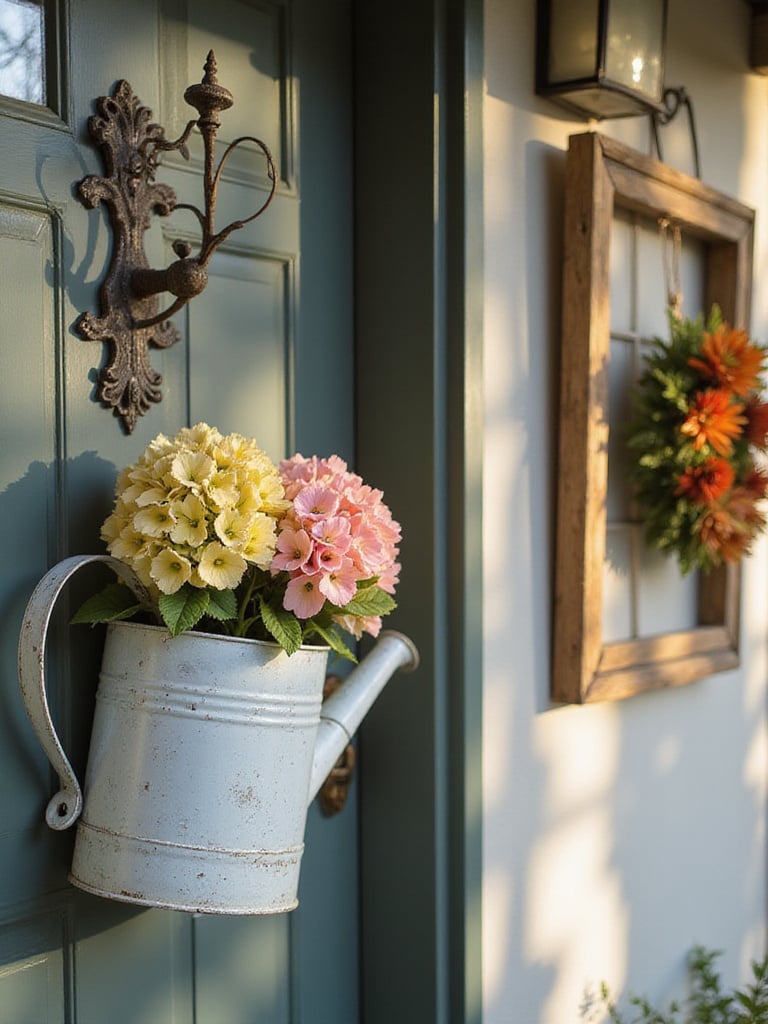
Old watering cans, wooden crates, or ceramic vessels make excellent planters when verified safe and weather-sealed with pet-safe products. Strip any questionable finishes and refinish with modern, non-toxic sealers that protect both the item and your pets. The patina and character of vintage pieces often improve with careful restoration that prioritizes safety.
Test vintage metal items for lead content using home test kits, and avoid pieces with flaking paint or unknown treatment histories. When in doubt, enjoy vintage pieces for their aesthetic inspiration but recreate the look using new, verified safe materials.
The cultural heritage preserved in each piece includes the stories they tell, but your pets’ safety takes priority over historical authenticity when conflicts arise.
16. Install Smart Lighting with Pet-Friendly Features
Smart lighting systems offer tremendous benefits for pet households—motion activation provides hands-free illumination when returning from walks, while programmable schedules can help anxious pets adjust to seasonal daylight changes. Choose systems that integrate with your existing smart home setup for seamless operation.

The key features for pet households include motion sensors that distinguish between pet and human movement, preventing constant activation from cats or small dogs while still responding to approaching visitors. Gradual dimming capabilities help pets adjust to lighting changes, while color temperature adjustment can support natural circadian rhythms for both humans and animals.
Installation considerations include protecting all wiring from chewing damage and ensuring fixtures don’t create hot surfaces that could burn curious pets. LED systems run cooler and last longer, making them ideal for households where fixtures might experience occasional pet interaction.
Smart lighting features for pet households:
- Motion detection with size discrimination
- Gradual dimming for anxiety reduction
- Cool-running LED technology
- Protected wiring and fixtures
The unexpected environmental benefit comes from the energy efficiency of LED systems combined with smart scheduling that eliminates wasted illumination.
17. Apply Pet-Safe Window Treatments to Door Glass
Decorating door glass requires special consideration for pet safety—avoid films or decals that contain harmful chemicals or could be peeled off and ingested by curious pets. Look for products specifically labeled as non-toxic and designed for households with children and pets.

Static cling films work better than adhesive options, as they don’t require potentially harmful glues and can be removed cleanly if pets do manage to access them. Choose designs that provide privacy without completely blocking natural light, helping pets maintain their connection to outdoor activities while protecting your interior from view.
The application process should include thorough surface preparation to ensure strong adhesion that prevents edges from lifting where pets might investigate. Consider professional installation for large or complex applications to ensure proper adhesion and safety.
Beyond aesthetics, the ecological impact matters because many traditional window films contain PVC and other materials that don’t biodegrade safely—choose eco-friendly options when available.
18. Install Protective Kick Plates for Durability
Kick plates become essential in pet households where scratching, jumping, and general wear from pet traffic can quickly damage door surfaces. Choose materials that can withstand claw marks while maintaining their appearance—stainless steel and solid brass offer excellent durability and can be refinished if needed.

The height and coverage area should account for your largest pets’ potential impact zones. Dogs who jump to greet visitors might require taller protection, while cats who scratch might need coverage extending to door edges. Custom sizing ensures optimal protection without compromising your door’s aesthetic appeal.
Installation must be secure enough to withstand significant impact from large dogs or persistent scratching from cats. Use appropriate fasteners for your door material and consider professional installation for expensive doors where mistakes could be costly.
The construction technique that ensures longevity involves selecting materials that actually improve with age and use, developing attractive patinas that hide minor scratches while maintaining structural integrity.
19. Update Seasonal Decor with Non-Toxic Ribbons
Seasonal ribbon accents offer easy updates, but material selection becomes critical in pet households where curious animals might chew or ingest decorative elements. Natural fiber ribbons like cotton, jute, or hemp provide beauty without the risks associated with synthetic materials that could cause intestinal blockages.

Choose wider ribbons that are less likely to be completely consumed if pets do investigate, and secure all ribbon elements firmly to prevent loose ends from becoming tempting toys. Avoid ribbons with metallic threads, synthetic dyes, or chemical treatments that could be harmful if ingested.
The seasonal rotation strategy works particularly well with natural materials that can be composted safely at the end of their decorative life, supporting both home safety and environmental responsibility.
Safe ribbon materials for pet households:
- Natural cotton or linen fibers
- Jute or hemp for rustic looks
- Undyed or naturally dyed options
- Wide widths to prevent complete ingestion
The finishing touch that elevates the entire look involves coordinating ribbon colors with your existing decor while prioritizing materials that won’t harm curious pets.
20. Add Pet-Friendly Seating for Welcoming Charm
Including seating in your entrance design creates welcoming appeal while serving practical purposes in pet households—a convenient spot for putting on shoes before walks, a place for visitors to interact with friendly pets, or storage for leashes and pet supplies. Choose materials that can withstand both weather and pet interaction.

Teak, cedar, or powder-coated metal options provide durability, while cushions made from outdoor fabrics resist moisture and can be easily cleaned after pet contact. Consider storage benches that keep pet supplies organized and readily accessible while maintaining a clean appearance.
The placement should account for pet traffic patterns—avoid blocking natural pathways pets use to access the door, and ensure seating won’t tip if bumped by large dogs or used as a launching pad by cats. Proper proportions prevent overcrowding while maximizing functionality.
The psychological ‘welcome’ factor increases when seating accommodates both human visitors and pet interactions, creating a space where everyone feels comfortable and included.
21. Coordinate Mailbox Design with Pet Safety
Your mailbox contributes to overall curb appeal while requiring consideration for pet safety—avoid designs with sharp edges, small decorative elements that could become choking hazards, or toxic finishes that might harm investigating pets. Choose substantial, well-constructed options that won’t be damaged by pet interaction.

Post-mounted mailboxes should be securely anchored to prevent tipping if bumped by large dogs, while wall-mounted options need secure attachment that won’t fail under stress. Consider the height and accessibility for both postal workers and pet owners who might be managing leashes while collecting mail.
The material selection should prioritize durability and safety—powder-coated steel, solid wood with pet-safe finishes, or naturally weather-resistant materials like cedar work well. Avoid painted surfaces that might contain harmful substances or decorative elements that could break off.
For post-mounted mailboxes, strategically planting low-maintenance, pet-safe shrubs around the base can soften its appearance while preventing pets from marking territory directly on the post.
22. Protect Decorations with Pet-Safe Treatments
Preserving your front door decorations requires weather protection products that won’t harm pets who might come into contact with treated surfaces. Many traditional sealers, paints, and protective coatings contain chemicals that are toxic to animals, making careful product selection essential.

Look for water-based sealers labeled as pet-safe once cured, and allow complete curing time before pets have access to treated surfaces. Natural protection methods like proper material selection and strategic placement often work better than chemical treatments in pet households.
The application process should include temporary barriers to prevent pet contact during drying and curing periods. Consider scheduling protective treatments when pets can be kept away from the area for appropriate time periods.
Pet-safe protection strategies:
- Water-based, non-toxic sealers
- Natural weather-resistant materials
- Strategic placement for protection
- Complete curing before pet access
Always secure decorations properly using heavy-duty, outdoor-rated hardware that won’t fail and create hazards for pets or family members.
23. Plan Pet-Conscious Holiday Transitions
Seamless seasonal transitions require extra planning in pet households where decorative changes might affect animal behavior or create safety concerns. Map out your decorating calendar with pet safety as a primary consideration, ensuring each seasonal change maintains a secure environment.

Create a rotation system using verified pet-safe materials that can be easily swapped without creating temporary hazards during transition periods. Store seasonal decorations in pet-proof containers that prevent access to potentially harmful materials during off-seasons.
The most successful seasonal decor plans start with a strong foundation of pet-safe base elements that remain constant, then layer in seasonal accents that have been verified safe for your specific pets and their behaviors.
Even better, the varied seasonal elements don’t just hide everyday pet-related wear—they celebrate it, creating a dynamic display that evolves with your family’s needs while maintaining safety standards.
24. Express Your Family’s Pet-Loving Personality
Your front door should reflect the complete personality of your household, including the beloved pets who make your house a home. Thoughtful integration of pet-themed elements creates authentic welcome while maintaining broad appeal and sophisticated design standards.
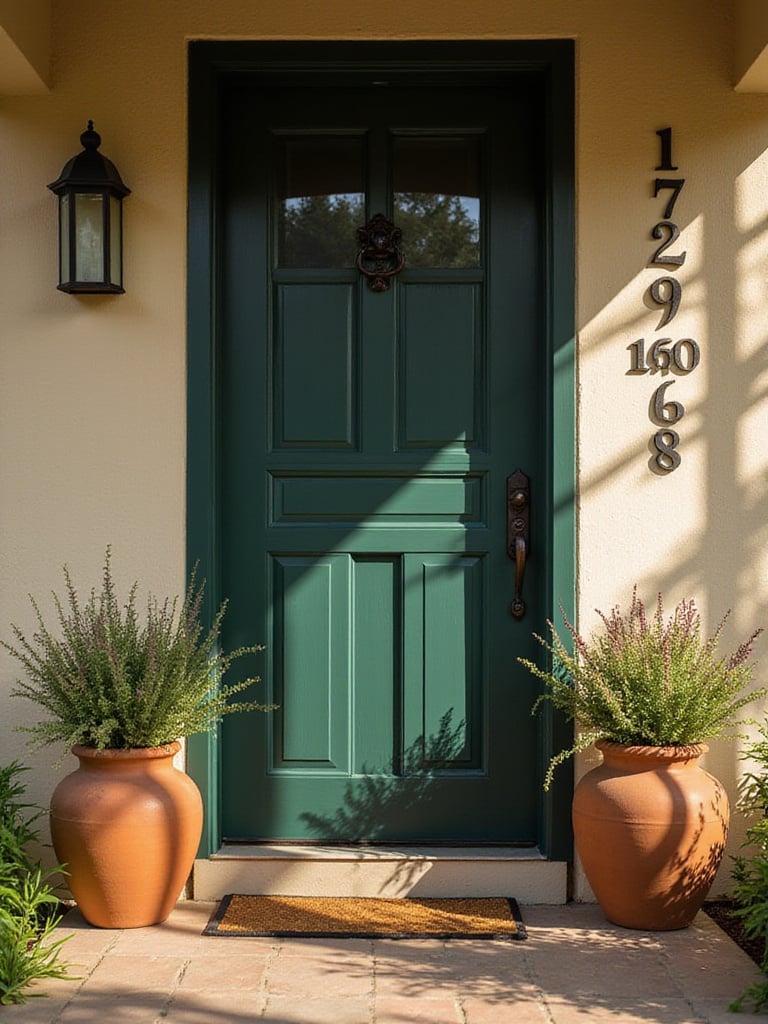
Subtle pet references work better than overwhelming displays—consider paw print door mats, pet silhouette house numbers, or seasonal decorations that nod to your animal family without dominating the aesthetic. The goal is creating an entrance that feels genuinely welcoming to fellow pet lovers while remaining attractive to all visitors.
The key to successful pet-inclusive design lies in balancing personality expression with safety considerations, ensuring every decorative choice supports both your aesthetic goals and your pets’ wellbeing. Quality materials, secure installation, and thoughtful placement create lasting beauty that celebrates your complete family.
Ways to include pet personality:
- Subtle paw print or silhouette accents
- Pet-safe plants in decorative arrangements
- Custom signage including pet family members
- Seasonal themes that celebrate pet activities
The emotional response this evokes begins with the recognition that your home welcomes all family members, creating immediate connection with visitors who share your love for animals.
Conclusion
Creating a stunning front door display that works for pet-loving families requires thoughtful planning, but the results are incredibly rewarding. These 24 decoration ideas prove that you don’t have to choose between style and safety—with careful material selection and strategic design choices, you can achieve both beautifully.
From pet-safe paint colors and durable hardware to seasonal decorations made with non-toxic materials, every element contributes to an entrance that welcomes both human and animal family members. The investment in quality, pet-conscious decorations pays dividends in longevity, safety, and the peace of mind that comes from knowing your beautiful home is also a safe haven for your beloved pets.
Remember that the best front door decorations tell the story of who lives inside. When that story includes furry family members, let your entrance celebrate that joy while maintaining the sophisticated appeal that makes your home a source of pride. Start with one or two elements that speak to your style and your pets’ needs, then build your perfect entrance over time. Your front door should be a welcoming preview of the love and care that fills your home—pets and all.
